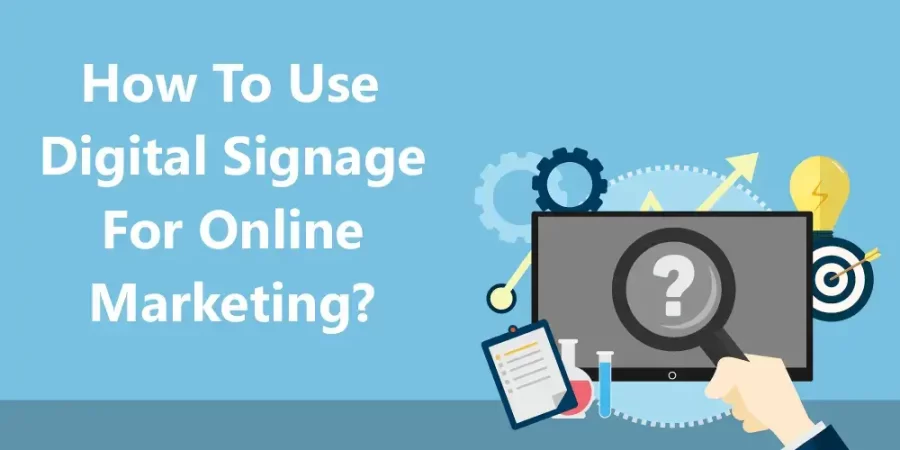Beginners Guide: How To Use Digital Signage For Online Marketing?
Digital signage is an increasingly popular method of advertising and promoting products or services. It involves using electronic displays, such as televisions or digital billboards, to display digital content, such as videos, images, or text. This content can be used to promote products, services, or events, and can be targeted to specific audiences or demographics. In this article, we will discuss how to use digital signage for online marketing, including the benefits of digital signage, the types of digital signage available, and best practices for creating and implementing a digital signage campaign.
Benefits of Digital Signage
- Targeted Advertising
One of the main benefits of digital signage is that it allows for targeted advertising. By displaying content on digital displays in specific locations, such as retail stores or public spaces, businesses can ensure that their message is reaching their desired audience. This allows for more efficient use of marketing resources and can increase the effectiveness of the campaign.
- Flexibility
Another benefit of digital signage is its flexibility. Digital displays can be easily updated with new content, making it easy to change a campaign or message as needed. This allows businesses to quickly respond to changes in the market or to customer feedback, and can help ensure that the campaign stays relevant and effective.
- Cost-effective
Digital signage can also be a cost-effective form of advertising. Instead of printing and distributing physical materials, businesses can create and display digital content, which can be cheaper and more environmentally friendly. Additionally, digital displays can be remotely managed, reducing the need for on-site maintenance and labor costs.
Types of Digital Signage
- Digital Billboards
Digital billboards are large electronic displays that are usually located in high-traffic areas, such as on highways or in busy city centers. They can be used to display a variety of content, including videos, images, and text. Digital billboards are a popular form of outdoor advertising and can reach a large audience.
- In-store Displays
In-store displays are digital signs that are located within retail stores, such as on the walls or on display stands. These displays can be used to promote products, services, or events, and can be targeted to specific audiences, such as customers in a specific store location or demographic.
- Interactive Displays
Interactive displays are digital signs that allow customers to interact with the content, such as by touching or moving the display. This can be used to create engaging and interactive experiences, such as virtual tours or product demonstrations.
Best Practices for Digital Signage
- Develop a clear strategy
To effectively use digital signage for online marketing, businesses should develop a clear strategy. This should include the goals of the campaign, the target audience, and the type of content that will be displayed. Having a clear strategy will help ensure that the campaign is effective and reaches the desired audience.
- Create engaging content
The content that is displayed on digital displays should be engaging and eye-catching. This can be achieved through the use of high-quality images, videos, and animations, as well as by using text that is easy to read and understand.
- Measure and analyze results
Finally, businesses should measure and analyze the results of their digital signage campaign. This can be done through the use of analytics tools, such as those provided by the digital signage software, to track the number of views and engagement with the content.
When using digital signage for online marketing, it is also important to consider the design and layout of the digital displays. The content should be arranged in an easy-to-read and visually appealing way, and should be updated regularly to keep the audience engaged. Additionally, businesses should consider incorporating interactive elements, such as touch screens or motion sensors, to create an interactive and engaging experience for the audience.
Another important aspect of digital signage is the use of analytics to track the performance of the campaign. By using analytics tools, businesses can measure the number of views and engagement with the content, as well as the demographics of the audience that is viewing the content. This information can be used to make adjustments to the campaign as needed and to improve the effectiveness of the digital signage.
Another important aspect of digital signage is the use of analytics to track the performance of the campaign. By using analytics tools, businesses can measure the number of views and engagement with the content, as well as the demographics of the audience that is viewing the content. This information can be used to make adjustments to the campaign as needed and to improve the effectiveness of the digital signage.
Another thing to consider when using digital signage for online marketing is the use of social media and other digital platforms to promote the campaign. By using social media and other digital platforms, businesses can increase the reach of the campaign and target specific audiences. Additionally, businesses can use social media to engage with their audience and to gather feedback on the campaign.
Here are some key takeaways from the article on “How to use digital signage for online marketing”:
- Digital signage is an increasingly popular method of advertising and promoting products or services, involving the use of electronic displays to display digital content.
- Benefits of digital signage include targeted advertising, flexibility, and cost-effectiveness.
- Types of digital signage include digital billboards, in-store displays, and interactive displays.
- Best practices for digital signage include developing a clear strategy, creating engaging content, and measuring and analyzing results.
- When using digital signage for online marketing, it is important to consider the design and layout of the digital displays, and to update the content regularly to keep the audience engaged.
- Incorporating interactive elements, such as touch screens or motion sensors, can create an interactive and engaging experience for the audience.
- Using analytics tools can be used to track the performance of the campaign, measure the number of views, engagement with the content and demographics of the audience.
- Social media and other digital platforms can be used to promote the campaign, increase the reach and target specific audiences. Social media can also be used to engage with the audience and gather feedback on the campaign.
- One important aspect of digital signage is the use of a content management system (CMS) to manage and update the digital content. A CMS allows businesses to easily create, schedule and publish content, making it easy to update and change the campaign as needed.
- Another important aspect of digital signage is the use of scheduling to ensure that the right content is displayed at the right time. This can be done by scheduling content to be displayed based on factors such as time of day, day of the week, or even weather conditions.
- In addition, businesses can use digital signage to display real-time information such as stock prices, weather forecast, or social media feeds to keep their audience informed and engaged.
- Businesses can also use digital signage to create a sense of urgency by displaying time-sensitive information such as limited-time offers or flash sales.
- To be successful with digital signage, businesses should also keep accessibility in mind. This includes making sure that the content is legible and easy to read, as well as providing alternative methods of accessing the content for those with disabilities.
- Another important aspect of digital signage is the use of data and analytics to track the performance of the campaign and make adjustments as needed. This can include tracking the number of views, engagement with the content, audience demographics and much more.
- Digital signage can also be used for customer engagement, by displaying real-time customer feedback, creating interactive polls, and encouraging social sharing.
- Lastly, businesses should consider the use of mobile integration, this includes using QR codes, NFC and other mobile technologies to provide an interactive and engaging experience for the audience.
In conclusion, digital signage is a powerful tool for online marketing that can be used to promote products, services, and events in an engaging and effective way. By utilizing targeted advertising, flexibility, and cost-effective methods, businesses can reach a large audience and drive sales.
The various types of digital signage, including digital billboards, in-store displays, and interactive displays, offer a wide range of options for businesses to choose from. Additionally, by following best practices such as developing a clear strategy, creating engaging content, and measuring and analyzing results, businesses can ensure the success of their digital signage campaign.
Furthermore, by using social media, mobile integration, and data analytics, businesses can enhance the reach and effectiveness of the campaign. By considering all of these aspects, businesses can develop a comprehensive and successful digital signage strategy that meets their marketing objectives.





Leave a Reply